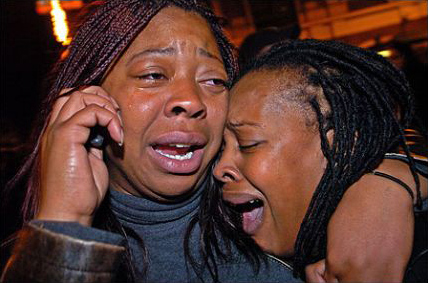It used to be so simple: Whether I needed to make my way through a police roadblock or explain to curious neighbors why I was taking pictures on their block, barking just two words usually did the trick: “Daily News!” In one breath, the transaction was complete. I had told them something about the authority behind my presence, and at the same time let them know exactly where they’d find my photos—in the next day’s paper.
I spent the better part of 17 years with the Philadelphia Daily News as a staff photographer and, eventually, the newsroom’s first video journalist. Then, 10 months after taking a buyout, I found myself unable to respond to a local deli clerk’s simple question: “What do you do for a living?”
My Web site described me as a backpacking, independent, live-blogging, entrepreneurial, economically sustain-able, all-platform, multimedia, visual journalist, educator and consultant—and it wasn’t entirely a joke. I was all of those and none of those, depending upon the challenges of each day.
Schooled in Social Media
My professional identity began to splinter in 2007 when I began producing video news reports and found myself struggling to explain where anybody could find my work. The steps to locating it were these:
- Send everybody to the Philadelphia newspapers’ Web site, philly.com.
- Steer them to the Daily News tab.
- Direct them to the “Watch This” section, then the “More Multimedia” link.
- Instruct them to read through a text list of content and click on my report.
My video news report would play right after a commercial for new cars or health insurance, both of which often were juxtaposed uncomfortably with the breaking news I often covered.
Needless to say, my videos weren’t getting a lot of clicks. And my Web surfing habits led me to believe there had to be a better way to get my content seen, so—with no training money in the newsroom’s budget—I laid out my own cash and burned some comp time to go to Las Vegas for my first Blog World Expo. And I promptly got schooled in the basics of online distribution and monetization.
I joined dozens of social networks and set up every account with the same user name—think branding—and I arranged to be e-mailed when a member friended, linked, followed me, or became a fan. Over time, some sites turned out to matter more, a few are defunct, and from others I never heard a peep. I also began using video distribution sites to post my work to social networks. Soon, my stories could be found on YouTube and other video sites or as iTunes podcasts. Updates would appear on my blog.
A year later, further budget cuts were making my job ever more difficult, and I saw little multimedia progress at the office. I got the feeling that what I’d learned in Vegas might as well have stayed in Vegas. When buyouts came along, I raised my hand, intending to apply the severance toward a sabbatical year as I threw myself into learning all I could about social media, monetization, content distribution, and their implications for journalism.
I still wanted to do this kind of work—communicating information that matters. And as I launched my own blog, I gradually came to understand that I’d always be a journalist, whether or not I carried an employer’s credentials. All I needed were three things: content, an audience, and revenue.
I looked for guidance. At the Online News Association meeting near Washington last fall, I heard Jeff Jarvis describe his entrepreneurial journalism course at the City University of New York. Then, as my friend George Miller prepared to teach a similar course at Temple University, I watched him develop the curriculum. And I made a return visit to Blog World Expo.
On my blog, I wrote some analytical posts about social media and its impact on the coverage of breaking news, especially during the plane crashes in Buffalo, New York, and in the Hudson River off Manhattan; the swine flu panic, and the infamous Air Force One fly-over photo op over Lower Manhattan. I posted—and marketed—my photos and videos of election night celebrations and holiday fireworks and much more. Among my news gathering and distribution tools are TweetDeck—a desktop Twitter client—and a number of Web sites that search Twitter posts. I use Tweetie to send my stories via my iPhone, which can post and link to photos and add live geotags.
Over time, traffic grew on my sites. Among the social media highlights of my news coverage are:
- When about 35,000 visitors came to my site after I posted celebration photos after the Phillies won the World Series. I’d sent links to several photo editors, and The Associated Press bought and distributed them.
- When Philly.com purchased and published some of my iPhone photos from the scene of a fatal fire, I was profiled by Philadelphia Weekly and even got blog mentions from BuzzMachine and Romenesko.
- When President-elect Obama’s inauguration train pulled out from 30th Street Station in Philadelphia, news choppers had been grounded for security purposes. I feel almost certain that my iPhone TwitPics were the first photos available anywhere.
So where do these eyeballs come from? In conversations I had with bloggers they shared with me strategies about audience-building and schooled me in the importance of creating and maintaining conversations with the online community. By Christmas I had about 3,000 Twitter followers; in July I was up to more than 50,000, and with tweets I was driving them to my blog and to newspaper sites where content originated. There were many days when I had 2,000 page views on my blog.
Building Connections
Now, I had to figure out how to monetize my work. I learned about cost-per-impression, cost-per-click and cost-per-action advertising, and opened numerous affiliate accounts. I was still making lunch money, but by July, I was approaching the level of blog traffic estimated to be necessary to sell sponsorships.
I poured countless hours into social media distribution, combining aggregated news content with creative human editing and occasional original content. Some argue that aggregation adds nothing and that aggregators are mere parasites, regurgitating content already available at mainstream sites, but I disagree. Services like mine connect disenfranchised communities with important news, and they repay the content creators by sending my audience their way.
Intelligence Group, a market research company, interviewed a college student whose perspective seems to neatly sum up how the “social media generation” sees the world: “If the news is that important, it will find me.” With young people, in particular, information today is shared, not sought.
By July, I was the second-most followed Twitter user in Philadelphia, behind only Ahmir “?uestlove” Thompson of The Roots. Sometimes I’d break into the top 500 global users, ahead of some celebrities, star athletes, mainstream news outlets, and other staffed accounts.
I think it’s fair to say that my editing and distribution techniques—and my interactions with my audience—earned me this influence. In conversing online, I’ve gained a broader understanding of the news consumer and discovered new content. My online audience immediately let me know not only their opinions about my reporting, but also where I could go for more information—I’ll never forget the day I discovered the Twitpic of the USAir plane in the Hudson.
Given my online experiences—mixed in with what I know about newspapers—I’m starting to suspect that social media might never work as well for these larger, old media outlets. Social media works well for entrepreneurs, as it does for celebrities and star athletes, because we have complete authority. We direct the endeavor and can be swift and nimble. Those aren’t always attributes readily associated with traditional news organizations these days.
City University in Birmingham, England, has recognized the significance of this new age by offering a master’s degree program in social media. The “Internet Famous” course at Parsons The New School for Design challenges the relationship between excellence and recognition, but applies distribution and reputation management strategies that certainly every journalist would benefit from learning.
Social media needs to be part of the curricula for training journalists, so I feel fortunate to be able to take the lessons I’ve learned in my life-after-my-buyout into the classroom. In August, I joined the convergence faculty at the University of Missouri School of Journalism and will teach there for at least a year. In preparing for this transition, I’ve refocused my blog (jimmacmillan.net) more closely around convergence journalism education and media industry matters and launched an accompanying Twitter account, writing there as @missourijim.
I don’t know if I’ll return to the life of a backpacking, independent, live-blogging, entrepreneurial, economically sustainable, all-platform, social media, multimedia, visual journalist, but the experience was priceless. Without walking down that road and having to find my way, I’m not sure I’d be ready to teach students who will be carving out their own roads in journalism.
Jim MacMillan teaches convergence journalism at the University of Missouri School of Journalism. He worked for 17 years as a staff photographer for the Philadelphia Daily News.







